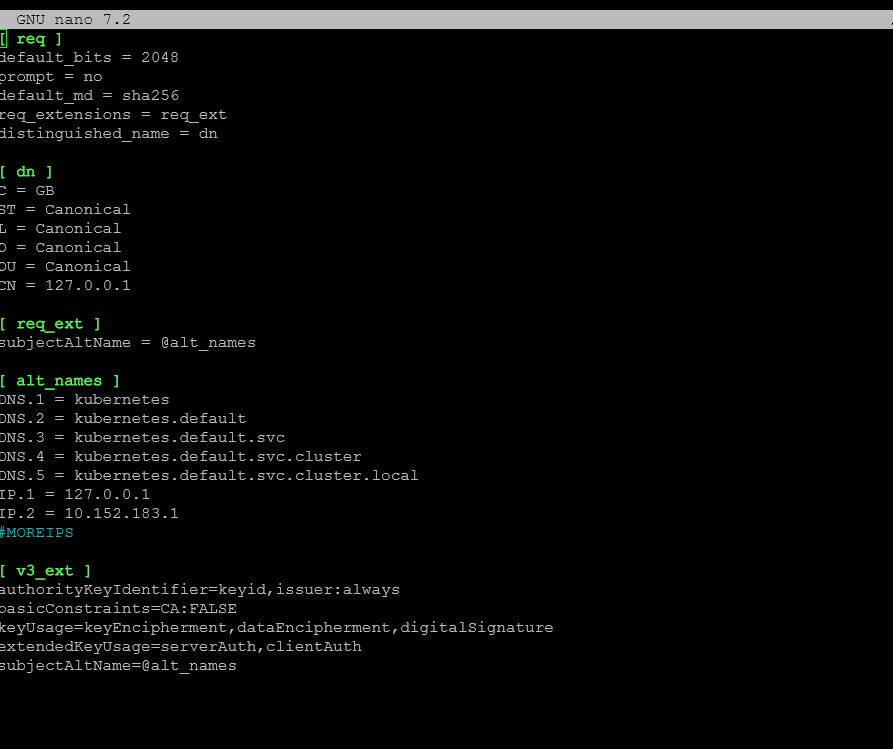Jan 26, 2025 11:46 am
Here are my cheat notes on how to install Kube VIP in Microk8s kubernetes cluster. First, edit the csr.conf.template file found here:
sudo vi /var/snap/microk8s/current/certs/csr.conf.template

Add the IP address as IP.99="a.b.c.d" to the file. Then refresh your microk8s certificates:
sudo microk8s refresh-certs -e ca.crt
Create a values.yaml file. You can find an example here:
https://github.com/kube-vip/helm-charts/blob/main/charts/kube-vip/values.yaml
It will look something like this below. Replace the config: address with your address that will be the VIP and change any other settings here you would like, but most can use defaults.
# Default values for kube-vip.
# This is a YAML-formatted file.
# Declare variables to be passed into your templates.
image:
repository: ghcr.io/kube-vip/kube-vip
pullPolicy: IfNotPresent
# Overrides the image tag whose default is the chart appVersion.
# tag: "v0.7.0"
config:
address: ""
# Check https://kube-vip.io/docs/installation/flags/
env:
vip_interface: ""
vip_arp: "true"
lb_enable: "true"
lb_port: "6443"
vip_cidr: "32"
cp_enable: "false"
svc_enable: "true"
svc_election: "false"
vip_leaderelection: "false"
extraArgs: {}
# Specify additional arguments to kube-vip
# For example, to change the Prometheus HTTP server port, use the following:
# prometheusHTTPServer: "0.0.0.0:2112"
envValueFrom: {}
# Specify environment variables using valueFrom references (EnvVarSource)
# For example we can use the IP address of the pod itself as a unique value for the routerID
# bgp_routerid:
# fieldRef:
# fieldPath: status.podIP
envFrom: []
# Specify an externally created Secret(s) or ConfigMap(s) to inject environment variables
# For example an externally provisioned secret could contain the password for your upstream BGP router, such as
#
# apiVersion: v1
# data:
# bgp_peers: "<address:AS:password:multihop>"
# kind: Secret
# name: kube-vip
# namespace: kube-system
# type: Opaque
#
# - secretKeyRef:
# name: kube-vip
extraLabels: {}
# Specify extra labels to be added to DaemonSet (and therefore to Pods)
imagePullSecrets: []
nameOverride: ""
fullnameOverride: ""
# Custom namespace to override the namespace for the deployed resources.
namespaceOverride: ""
serviceAccount:
# Specifies whether a service account should be created
create: true
# Annotations to add to the service account
annotations: {}
# The name of the service account to use.
# If not set and create is true, a name is generated using the fullname template
name: ""
podAnnotations: {}
podSecurityContext: {}
# fsGroup: 2000
securityContext:
capabilities:
add:
- NET_ADMIN
- NET_RAW
drop:
- ALL
resources: {}
# We usually recommend not to specify default resources and to leave this as a conscious
# choice for the user. This also increases chances charts run on environments with little
# resources, such as Minikube. If you do want to specify resources, uncomment the following
# lines, adjust them as necessary, and remove the curly braces after 'resources:'.
# limits:
# cpu: 100m
# memory: 128Mi
# requests:
# cpu: 100m
# memory: 128Mi
volumes: []
# Specify additional volumes
# - hostPath:
# path: /etc/rancher/k3s/k3s.yaml
# type: File
# name: kubeconfig
volumeMounts: []
# Specify additional volume mounts
# - mountPath: /etc/kubernetes/admin.conf
# name: kubeconfig
hostAliases: []
# Specify additional host aliases
# - hostnames:
# - kubernetes
# ip: 127.0.0.1
nodeSelector: {}
tolerations:
- effect: NoSchedule
key: node-role.kubernetes.io/control-plane
operator: Exists
affinity: {}
# nodeAffinity:
# requiredDuringSchedulingIgnoredDuringExecution:
# nodeSelectorTerms:
# - matchExpressions:
# - key: node-role.kubernetes.io/master
# operator: Exists
# - matchExpressions:
# - key: node-role.kubernetes.io/control-plane
# operator: Exists
podMonitor:
enabled: false
labels: {}
annotations: {}
priorityClassName: ""
Finally, we need to add the helm repo for kube-vip, update, and then install:
microk8s helm3 repo add kube-vip https://kube-vip.io/helm-charts microk8s helm3 repo update microk8s helm3 install kube-vip kube-vip/kube-vip --namespace kube-system -f values.yaml
Hopefully, this will help anyone trying to get this up and running.

